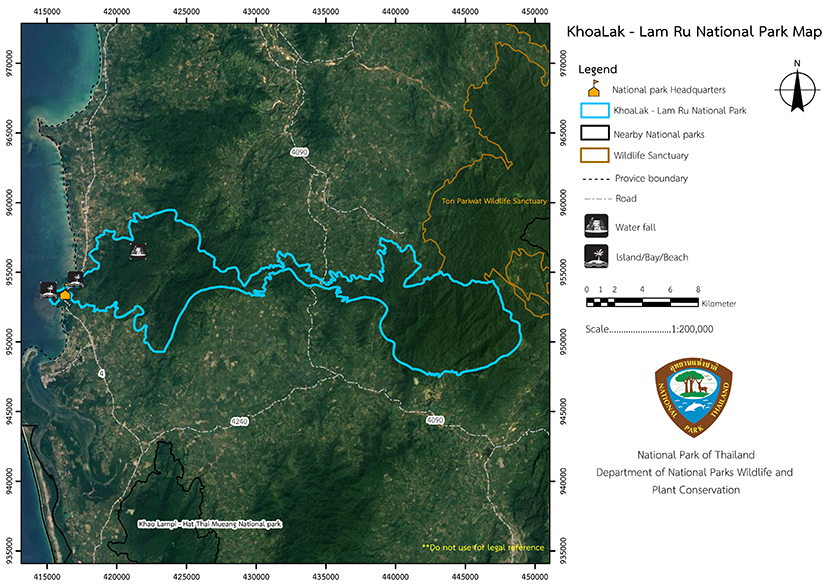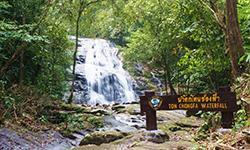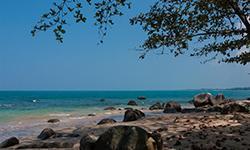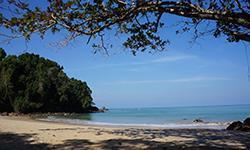Khao Lak – Lam Ru National Park
Contact Location : Khao Lak-Lam Ru National Park, Moo 7, Khuekkhak Sub-district, Takua Pa District, Phang-Nga Province, 82190
Telephone Number : (+66) 7 648 5243
Email : khaolaklumru.dnp@gmail.com
Facebook : Khaolak-Lamru National Park
Information
-
Background
Chai Thale Khao Lak Forest Park is under the responsibility of the National Park Division, In 1984,
the village headman of Moo 2, Kapong Sub-district, Phang-Nga Province, issued a letter to the Deputy Minister of Agriculture and Cooperatives stating that the area of Lam Ru Waterfall, which is located in the Thueak Khao Kadai National Reserved Forest, Kapong Sub-district, Phang-Nga Province, has surrounding fertile forests. Therefore, the Ministry of Agriculture and Cooperatives issued an order for the Royal forest Department
to consider the forest resources and wildlife worth preserving. Then the National Park Division proposed a letter to the Royal Forest Department to order the officials to conduct the surveys which confirmed that th forest
area was fertile with many natural features that were suitable to become a a national park.
In 1985, the National Park Division had a letter proposed to the Royal Forest Department to order
the officials to establish a national park named “Namtok Lam Ru National Park.” Later, the Permanent Secretary of the Ministry of Agriculture and Cooperatives ordered the Royal Forest Department to preserve Khlong Lam
Ru Yai Forest, Lam Kaen Sub-district, Thai Mueang District, Phang-Nga Province, with the approval of the Phang-Nga Naval Station Commander, and the resolution of the Lam Kaen Sub-district Thai Mueang
District Council. They wanted to preserve the watershed forest of the Khlong Lam Ru Yai .
The Royal Forest Department asked the Watershed Conservation Division to investigate, and after a joint meeting between the involved agencies on June 7, 1985, they agreed that the National Park Division should explore the area in order to establish a national park.
The National Park Division was ordered Namtok Lam Ru National Park to conduct more surveys and the reports showed that Lam Ru Waterfall and the forest upstream of Lam Kaen Sub-district cover a total surveyed area of about 150 square kilometers in 7 National Reserved Forests. It is an important watershed in Phang-Nga Province, and there are abundant forests with many unique natural features that are suitable to become national parks.
In 1988, Namtok Lam Ru National Park received a letter requesting that it rename the new national park to better suit the location and have a pronounced meaning. The National Park Division has considered and approved the use of the name, which was Khao Lak - Lam Ru National Park, which is derived fom the name of the seaside area at Khao Lak and the Lam Ru Waterfall. The Khao Lak - Lam Ru National Park was declared a National Park under the National Park Act, 1961 A royal decree specified the land of ??the Thueak Khao Lak Forest, Khao Ton Forest and Chai Thale Khao Lak Forest, the Thueak Khao Kradai Forest, Khao Lak Forest, Lam Ru Forest, Kuan Hua Ton Forest, Khao Phang Forest, and Thueak Khao Katha Khwam Forest in the Khuek Khak Sub-district, Takua Pa District, Kapong and Mo Sub-district, Kapong District, Lam Kaen and Lam Phi Sub-district, Thai Mueang District, and Thung Kha Ngok Sub-district, Mueang District, in Phang-Nga Province. It is an area of 125 square kilometers, and became Thailand’s 66th national park in Volume 108, Part 152, dated August 30, 1991.
Note : After paying the entrance fee to the National Park, please carry the receipt for inspection.

78,125 rai (125 square kilometers)
|
|
|
||
|
|
|||
Nature trails ⇔ Visit Waterfall ⇔ Take a boat ride or a paddle
Welfare shop : (Food, Drink, Icescream) Open Daily 09.00 - 16.30 hrs.
National Park Headquarters: AIS, TRUE
Visitor center area and accommodation: AIS, TRUE
|
|
The general terrain is that of mountains and steep mountains, such as Khao Lak, Khao Lam Ru, Khao Saeng Thong, Khao Mai Kaeo, and Khao Plai Bang To. The highest peak is about 1,077 meters above sea level and the area is the catchment area of major rivers in Phang-Nga Province, including the Takua Pa River and the Phang-Nga River. It also consists of canals and many smaller creeks. The location of the Khao Lak - Lam Ru National Park Headquarters is at the coast adjacent to the sea on the west side of the national park. It is located in a rocky beach ecosystem which is about 3 kilometers long and has a sandy beach.
|
|
Khao Lak - Lam Ru National Park is located on the west coast of the Andaman Sea; therefore, it receives influence from the southwest monsoon and northeast monsoon, causing rain almost all year round. There are only two seasons; summer starts from January until April, and the rainy season starts from May until December. The best period for tourism is between late December and April each year.
|
|
|
|
|
General forest conditions within the Khao Lak-Lam Ru National Park area consist of: Tropical Rain Forest, which covers almost all of the Khao Lak - Lam Ru National Park. The important plants in it are Dipterocarpus baudii Korth., Dipterocarpus kerrii King, Parashorea stellata Kurz, Hopea pierrei Hance, Anisoptera costata Korth., Swintonia schwenckii (Teijsm. & Binn.) Teijsm. & Binn. ex Hook.f., Mesua ferrea Linn., Parishia insignis Hook.f., and Cinnamomum parthenoxylon (Jack) Meisn., Litsea elliptica Blume, Phoebe paniculata Nees, Scima wallichii, Adinandra integerrima T.Anderson ex Dyer, Purple Millettia,Heritiera sumatrana (Miq.) Kosterm. Malvaceae. ., Knema laurina (Blume) Warb. Parkia speciosa Hassk., Parkia timoriana (DC.) Merr., Devil tree, Spondias mombin (L.), Elaeocarpus tectorius (Lour.) Poir., Aphanamixis polystachya, Nephelium maingayi Hiern, and Xerospermum intermedium . The shrub trees include Ixora cibdela Craib, Clerodendrum indicum Kuntze, Wrightia dubia (Sims) Spreng., Trevesia valida Craib, Psychotria asiatica L., Sterculia lanceolata Cav. var. lanceolata, Ficus chartacea Wall. ex-King var. chartacea, Red-leaved Mapania, Ancistrocladus tectorius (Lour.) Merr, Willughbeia edulis Roxb., Bauhinia integrifolia Robx., Entada rheedii, Piper lonchites Roem & Schult., Paraderris elliptica (Wall.) Adema, Freycinetia sumatrana Hemsl., and Photos scandense L. The herbaceous plants found on the ground include Kaempferia roscoeana Wall., Boesenbergia prainiana (King ex Baker) Schltr., Persicaria glabra (Willd.) M.Gómez, Crape Ginger, Alpinia zerumbet (Pers.) B. L. Burtt & R.M. Sm., Aglaonema simplex Blume, Alocasia longiloba Miq., Lasia spinosa, Molineria latifolia (Dryand. ex W.T. Aiton) Herb. ex Kurz var. latifolia, Schumannianthus dichotomus (Roxb.) Gagnep, Donax canniformis (G. Forest) K. Schum, Tacca chantrieri André, Tacca integrifolia Ker Gawl. A parasitic plant found is Sapria ram. There are also palm species such as Avenga pinnata, Lguanura polymorpha Becc., Artemisia annua, Licuala Spinosa Thunb, Livistona speciosa, Caryota mitis Lour., and Oncosperma horrida, and rattan and bamboo products include M. bumillis Kurz and Gigantochloa Densa. The epiphyte plants found are ferns such as Microsorum punctatum (L.) Copel., Dischidia Imbricata (Blume) Steud., Nephrolepis falcata (Cav.) C. Chr., Pteris biaurita L., Angiopteris evecta (G. Forst.) Hoffm., Selaginella willdenowii (Desv. ex Poir.) Baker, and Cyathea contaminans (Wall. ex Hook.) Copel. The gymnosperm plants are Khun Mai (Nageia wallichiana (C.Presl) Kuntze)and Phaya Mai (Podocarpus neriifolius D.Don), with the giant trees in the area having a circumference of 205 centimeters and a height of about 40 meters. The beach forest is a plant community that grows on the coast in sandy soil or the scattered rocks of the coastal area. Many of the plants are halophytes due to the influence of salt vapor from the sea. Plant species include Calophyllum inophyllum L., Terminalia catappa, Fish Poison Tree, Derris indica (Lamk.) Benn., Hernandia nymphaeifolia (Presl) Kubitzki, Thespesia populnea (L.) Sol. ex Corrê, Hibiscus tiliaceus, Cerbera odollam Gaertn., Casuarina equisetifolia, Guettarda speciosa L., and Acrostichum aureum L.. Most of the plant species found have short, crooked or bent trunks because of the strong winds at the coast. Shrub found include Scaevola taccada (Gaertn.) Roxb and the herbaceous plant Goat's Foot Creeper. In addition, the areas with scattered rocks or the sandy beach can host mangrove plant species which grow from seedlings brought by the sea current to the shore where they germinate, such as Avicennia marina (Forssk.) Vierh., Lumnitzera littorea (Jack) Voigt, Xylocarpus granatum Koenig, Combretum indicum (L.) DeFilipps, Bruguiera cylindrica (L.) Blume., Black Mangrove, Rhizophora apiculata Blume, Rhizophora mucronata Lam., Scyphiphora hydrophyllacea C. F. Gaertn. and Excoecaria agallocha L. Due to the forest's geography, climate, and vegetation composition, there is an abundance of plants, food, and water sources. As a result, it is the habitat of significant wildlife, including mammals such as Chamois, Tapir, Southern Chipmunk, Marmot, Hook Bear, Small Mongoose, leeches, and the Large White-Eared Bat as well as other types of bat Reptiles include a flying chameleon with Orange-winged Flying Lizard, Greater Spiny Lizard, Bengal monitor, , Sunbeam Snake (Xenopeltis unicolor), Common Keelback (Xenochrophis flavipunctatus), Malayan Pit Viper and Trimeresurus albolabris are just a few of the species. Amphibians are frequently found in waterlogged or wet areas including the Smith's litter frog (Leptobrachium smithi), the Giant jungle toad, Broad-headed Frog , and the Dark-sided Chorus Frog, all of which are nocturnal. Birds: Crested Serpent-Eagle (Spilornis cheela), White-Bellied Sea-Eagle, GreyCcapped Emerald Dove, Scarlet Minivet, Bushy-Crested Hornbill, Oriental Pied Hornbill, and Great Hornbill. Butterflies: The Common Rose, Lime Butterfly, Black and White Helen, Leptosia nina malayana, The Psyche, Common Albatross, Lemon Emigrant, Common Fivering, Common Evening Brown, Common Cruiser, Common Yeoman, Chocolate Pansy, Lebadea martha, and Jamides celeno aelianus. Marine Animals Sea Cucumbers including theBlack Sea Cucumber, White Sea Cucumber, Gut-like Sea cucumber, Long Spined Sea Urchins, Feather Star, crabs, shrimps Shellfish groups found include the Rare-Spine Murex, Tiger Cowries, Cypraea arabica, sea slugs, and nine top shells Fish: Giant Moray Eels, Lizardfish, Asian Freshwater Needlefish, Redcoat Squirrelfish, Stonefish, Lionfish, Groupers, Red-Banded Grouper, Cardinalfish, Suckerfish, Russell's Snapper, Pickhandle barracuda, Armored Catfish, Gourami, Butterflyfish, Pennant Coralfish, Abudefduf vaigiensis, Ocellaris Clownfish, Moon Wrasse, Cressent wrasse, Cleaner Fish, Blennioidei, and Diodon spp. |
How to get there by car :
From Bangkok, take Highway No. 4, Phetkasem Road to the KhaoLak - Lam Ru National Park Headquarters, which is 50 meters from the main road, where the Chao Pho Khao Lak Shrine is at the entrance.
How to get there by plane :
Take a flight to Phuket International Airport, and then drive to Khao Lak - Lam Ru National Park by taking the route along Highway No. 4 to Thai Mueang District, Takua Pa, Ranong.
How to get there by public buses :
At the Southern Bus Terminal, there are both air-conditioned buses and standard buses from Bangkok to Phuket and Bangkok to Takua Pa. The fare for the Bangkok -Phang-Nga route is around;
Common bus: 510 THB.
Air-conditioned: 670 THB.
VIP air-conditioned: 800 THB.
- National Park Ranger Station Kho Ro No. 1 (Namtok Lam Ru)
- National Park Ranger Station Kho Ro No. 2 (Namtok Ton Chong Fa)
- National Park Ranger Station Kho Ro No. 3 (Thung Kha Ngok)
Accommodation : Khao Lak 101 (Thep Taro 1) (Close)
Khao Lak 102-105 (Thep Taro 2-5)



